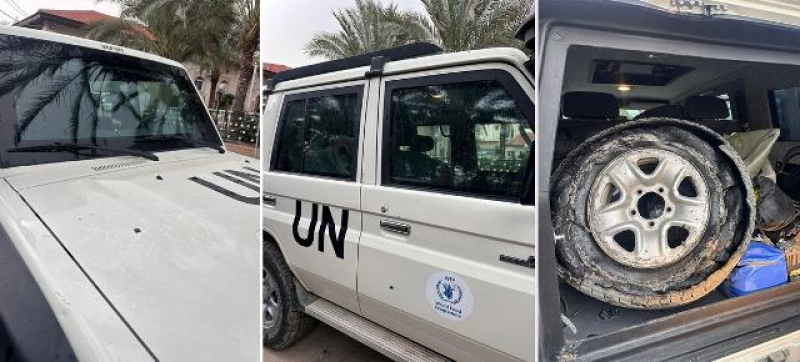- CA Yunus pays homage to Liberation War martyrs on Victory Day |
- Bangladesh capital market extends losing streak for second day |
- Bangladesh celebrates Victory Day Tuesday |
- 'Different govts presented history based on their own ideologies': JU VC |
World Food Program condemns Israeli attak on Gaza aid convoy

A WFP vehicle is left riddled with bullet holes and a shredded tyre after a convoy was attacked in Gaza. © WFP
6 January 2025 - Israeli airstrikes continued across Gaza overnight into Monday, while the UN World Food Programme (WFP) reported that one of its aid convoys in the war-shattered enclave was targeted by Israeli fire on Sunday.
The WFP issued a statement on Monday condemning the attack insisting that its vehicles had been “clearly marked”.
“At least 16 bullets” struck the convoy of three vehicles carrying eight staff members which came under fire near Wadi Gaza checkpoint. “Thankfully, no staff members were injured in this terrifying encounter,” the agency added.
All necessary clearances had been obtained from the Israeli authorities and WFP said that it was “just the latest example of the complex and dangerous working environment” confronting its teams.
Warehouse strike
The development comes amid reports that a missile struck a flour distribution warehouse in central Gaza run by a UN aid partner at the weekend, leaving three humanitarian workers seriously injured.
UN agency teams in the vicinity of the storage depot described hearing people screaming after the strike. They also reported looting and gunfire after Sunday’s blast at the MA’AN Development Center facility.
It has been 15 months since war erupted in Gaza, prompted by Hamas-led terror attacks on Israel that left some 1,200 dead in October 2023 and more than 250 people taken hostage.
Reported ceasefire talks between Palestinian officials and Israel have yet to result in an agreement to halt the violence or release those captured.
To date, Israeli bombardment from the air, land and sea continues to be reported across the Gaza Strip, where a harsh winter has set in.
Eight babies are reported to have died from hypothermia and more than 45,300 Palestinians have been killed and over 107,700 injured; one in five of that number has sustained life-changing injuries since 7 October 2023, according to the authorities.
Tensions rise in Lebanon
In Lebanon, the UN peacekeeping force there has urged all sides to the conflict to step back from any move that could jeopardize their fragile ceasefire, after Israel Defense Forces (IDF’s) “deliberate and direct destruction” of a line of withdrawal marker in southern Lebanon.
In a statement condemning the move at the weekend, the UN Interim Force in Lebanon (UNIFIL) described how peacekeepers observed an IDF bulldozer “destroying a blue barrel marking the line of withdrawal between Lebanon and Israel in Labbouneh, as well as an observation tower belonging to the Lebanese Armed Forces immediately beside a UNIFIL position there”.
The development marks “a flagrant violation of resolution 1701 and international law”, the UN Mission insisted, in reference to the Security Council resolution that was adopted following the 2006 war in Lebanon between Israel and Hezbollah, seeking to end their conflict.
Dangerous moves
In recent days, UNIFIL has also reported ongoing IDF operations north of the UN-patrolled Blue Line, despite a 60-day ceasefire agreement signed on 27 November 2024 by the Governments of Israel and Lebanon.
Specifically, it calls for Israel to withdraw from southern Lebanon and for Hezbollah to end its armed presence there, within the same timeframe.
The agreement was designed to end hostilities between Israel and Hezbollah that erupted once again in October 2023, following the start of the war in Gaza.
In a situation update, UN aid agencies reported that complex humanitarian needs persist in Lebanon.
According to the UN migration agency, IOM, more than 860,000 people uprooted within Lebanon by the recent conflict have now returned to their former communities, but nearly 124,000 remain displaced.
Since 8 December when the Assad regime collapsed, some 90,000 people have also arrived in Lebanon from Syria - both Lebanese and Syrian nationals - to face the “widespread destruction of homes and critical infrastructure, disruption in essential services, explosive ordnance risks, limited livelihoods and depleted coping mechanisms”, warned the UN refugee agency, UNHCR.
Those who remained in conflict-affected areas throughout the escalation of hostilities and “face dire conditions as essential services have been severely limited for a prolonged period”, the UN agency said, in a call for “immediate humanitarian relief and long-term recovery support”. – UN News

